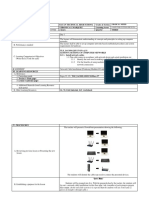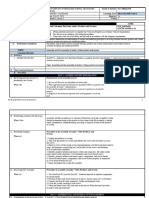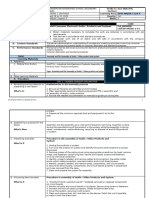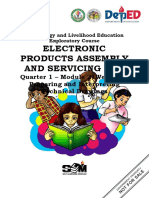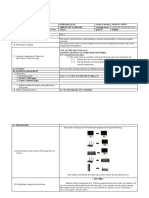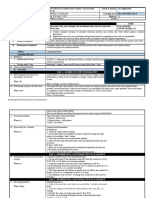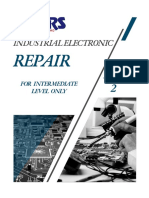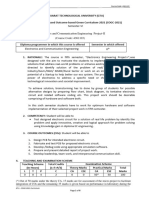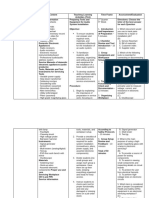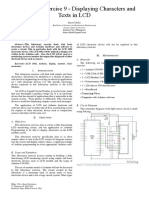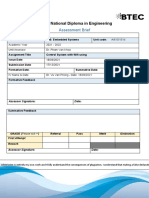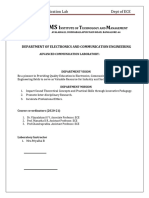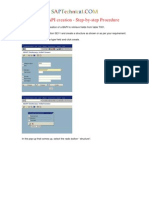DLL-EPAS12 MAJOR 5 & 6 Nov.11-15,2023
DLL-EPAS12 MAJOR 5 & 6 Nov.11-15,2023
Uploaded by
adonis.santiagoCopyright:
Available Formats
DLL-EPAS12 MAJOR 5 & 6 Nov.11-15,2023
DLL-EPAS12 MAJOR 5 & 6 Nov.11-15,2023
Uploaded by
adonis.santiagoCopyright
Available Formats
Share this document
Did you find this document useful?
Is this content inappropriate?
Copyright:
Available Formats
DLL-EPAS12 MAJOR 5 & 6 Nov.11-15,2023
DLL-EPAS12 MAJOR 5 & 6 Nov.11-15,2023
Uploaded by
adonis.santiagoCopyright:
Available Formats
School CONCEPCION INTEGRATED SCHOOL SECONDARY Grade & Section G12 SKILLFUL
LEVEL
Teacher ADONIS I. SANTIAGO Learning Area EPAS MAJOR 5 and 6
Date September. 11 to 15, 2023 Quarter 1st
Module Module 1 Lesson 2 Week 2
CODE
I. Most Essential Learning Install Consumer Electronic Audio / Products and Systems TLE_IAEPAS9-
Competency (MELC) 12SCEP-APSIIIc-e-53
Objectives A. Obtain materials necessary to complete the work are obtained in accordance with job requirements
B. Test devices in accordance with standard procedures
C. Clean/clear work site of all debris and left safe in accordance with the company requirements
D. Content Standards The learners demonstrate an understanding of concepts and underlying principles in servicing consumer electronic products and systems
based on customer description and standard procedures.
E. Performance Standards The learners shall be able to service consumer electronic products and systems (audio products and systems) based on
customer description and standard procedures
.
TOPIC Reading Circuit Diagram of Audio / Video Product and System
Learning Materials
A. Reference
1. Module from E-Libro SLM-TVL – Industrial Arts Electronic Products Assembly and Servicing Module 2: Install Consumer Electronic Audio /
Products and Systems. Topic: Reading Circuit Diagram of Audio / Video Product and System
2.
B. Other Learning Materials
II. Procedure
DAY 1 – GUIDED CONCEPT EXPLORATION
A. Reviewing previous lesson/s or When we talk of principles, processes, operations and simply how an electronics and electrical products and system works.
presenting a new lesson It is best represented in the universal language of drawings and symbols called the diagram.
What’s In What are the different types of diagrams?
B. Establishing a purpose for the lesson Electronic and Electrical Diagrams This is part of the documentation of the electronic products or systems which is included
in the service manual that cover the installation, servicing, repair, and maintenance of the products and system. This
What’s New sometimes serves as the road map of our device; it is an important part of the service manuals that serves as our guide in the
servicing process.
Types of Electronics and Electrical Diagrams –
1. Block Diagram
Developing Resilience, Building the Impossible Dreams 1
2. Pictorial or Wiring Diagram
3. Schematic Diagram
C. Presenting examples Block Diagram of a CRT TV
What is it This shows the different stages of the CRT TV that operates to process the RF to a useful Audio and Video information.
Starting from the antenna that intercept the radio frequency signal to the CRT for the reproduction of video images and
speaker for its audible sound. Block diagram is useful in identifying the function and operation of the different stages and
the direction of the signal flow.
D. Discussing New Concepts Pictorial or Wiring Diagram of an LCD TV Circuit Boards
What is it LCD TV is a type digital device. It contains much fewer components and stages than analog TV it is compact due to the use
of modern types of electronic components in the form of Surface Mounted Device Components (SMD
DAY 2 – EXPERIENTIAL AND INTERACTIVE ENGAGEMENT
E. Continuation of the discussion of new Schematic Diagram of Audio System This type of diagram uses standard symbols to represents components and its
concept connections. It gives vital information on the value and specification of components. Different test points and bias voltages
between points are shown as well as signal input and output, that serves to be important in troubleshooting the device.
What is it
DAY 3 – EXPERIENTIAL AND INTERACTIVE ENGAGEMENT
F. Developing Mastery
Instructions:
What’s More 1. Secure a service unit of an audio or a video products or system
2. Provide the schematic diagram of the device from its service manual.
3. Identify the different components connected to the device. Mark it on the diagram using a colored pen. a. Red for
Resistors b. Blue for Capacitors c. Green for Diodes d. Yellow for Transistors e. Orange for Relays and Switches f. Brown
for Integrated Circuits
]4. Identify the different voltage test point on the device. Mark it with a plus symbol.
5. Identify the different inputs and output terminals of the signal. Mark it with a > for input and < for output. If possible,
identify the type of signal input and output. Check it using an oscilloscope.
6. Trace the supply voltages. Use colored pen. a. Green for Standby Voltage b. Yellow for LV Secondary supply 12V to 24V
Developing Resilience, Building the Impossible Dreams 2
c. Red for B+ Primary supply 50V to 500V d. Black for HV 1000V up
G. Finding practical applications of
concepts and skills
What I Can Do
H. Making generalization and abstraction 1. Identified the 3 major parts of the Multi-Meter.
2. Proper use and handling of the Multi-Meter.
What I Have Learned 3. Selecting proper ranges when measuring the different electrical quantities.
4. Reading the meter scale with accuracy and precision when measuring voltages, current and resistances.
DAY 4 – LEARNERS-GENERATED OUTPUT
I.[H.] Evaluating learning
Assessment Perform the given activity 2.1, Record your progress and present it to your teacher online or during F2F schedules for
evaluation use pictures as your mode of verifications.
J.[I.] Additional activities for application or
remediation
Additional Activities
Developing Resilience, Building the Impossible Dreams 3
III. Remarks
IV. Reflection
A. No. of learners who earned 80% in 40
the evaluation
B. No. of learners who required 6
remediation
C. Did the remedial work? no. of 40
learners who have caught up
D. No. of learners who continue to None
require remediation
E. Which of my strategies work well? Peer to Peer Turoring
F. What difficulty did I encounter None
which my principal and supervisor
help me solve?
G. What innovation or localized Old Electronic Spare parts from previous servicing
materials did I use?
Prepared by:
ADONIS I. SANTIAGO
Teacher II, SHS-CISSL
Submitted to: Noted by:
ALLAN V. TUIBEO GLENDA M. TRINIDAD
SHS Coordinator Principal II
Developing Resilience, Building the Impossible Dreams 4
You might also like
- Computer Systems Servicing-DLLDocument55 pagesComputer Systems Servicing-DLLangelito alaras92% (84)
- Plans and Procedures Recovery Persons From Water FINALDocument38 pagesPlans and Procedures Recovery Persons From Water FINALRihards67% (6)
- Epas12 Major 5 - 6 September .11-15,2023Document4 pagesEpas12 Major 5 - 6 September .11-15,2023Adonis SantiagoNo ratings yet
- WEEK 4 2nd SEM DLL-EPAS12 MAJOR 7 & 8 Feb 19 - 23, 2024Document8 pagesWEEK 4 2nd SEM DLL-EPAS12 MAJOR 7 & 8 Feb 19 - 23, 2024adonis.santiagoNo ratings yet
- DLL-EPAS12 MAJOR 5 & 6 Sept 18 - 22, 2023Document5 pagesDLL-EPAS12 MAJOR 5 & 6 Sept 18 - 22, 2023adonis.santiagoNo ratings yet
- EPAS12 MAJOR 5 - 6 Sept 18 - 22, 2023Document5 pagesEPAS12 MAJOR 5 - 6 Sept 18 - 22, 2023Adonis SantiagoNo ratings yet
- Epas12 Major 5 - 6 Sept 25 - 29Document6 pagesEpas12 Major 5 - 6 Sept 25 - 29Adonis SantiagoNo ratings yet
- TLE G8-EPAS Q1 M2 NewDocument22 pagesTLE G8-EPAS Q1 M2 NewSHD TELEMEDICINENo ratings yet
- WEEK 2 2nd SEM DLL-EPAS12 MAJOR 7 & 8 Feb 05 - 09, 2023Document8 pagesWEEK 2 2nd SEM DLL-EPAS12 MAJOR 7 & 8 Feb 05 - 09, 2023adonis.santiagoNo ratings yet
- Epas12 Major 5 - 6 Aug 29 - Sept 1,20231Document6 pagesEpas12 Major 5 - 6 Aug 29 - Sept 1,20231Adonis SantiagoNo ratings yet
- WEEK 3 2nd SEM 3rd QRT DLL-EPAS12 MAJOR 7 & 8 Feb 12 - 163, 2024Document8 pagesWEEK 3 2nd SEM 3rd QRT DLL-EPAS12 MAJOR 7 & 8 Feb 12 - 163, 2024adonis.santiagoNo ratings yet
- Computer Systems Servicing DLLDocument55 pagesComputer Systems Servicing DLLAdrian Yan Yan Delara100% (1)
- DLL-EPAS12 MAJOR 5 & 6 Aug 29 - Sept 1,2023Document6 pagesDLL-EPAS12 MAJOR 5 & 6 Aug 29 - Sept 1,2023adonis.santiagoNo ratings yet
- 7-8 Tle Css Weeks 7Document8 pages7-8 Tle Css Weeks 7briszle.evangelistaNo ratings yet
- Industrial Arts Department: Self-Instructional Packets Electrical Installation and Maintenance 10Document9 pagesIndustrial Arts Department: Self-Instructional Packets Electrical Installation and Maintenance 10Aldrin Santos100% (1)
- EEE101L - Electrical Circuits I Laboratory - Manual - TrimesterDocument41 pagesEEE101L - Electrical Circuits I Laboratory - Manual - TrimesterRAFID ABRAR AHMEDNo ratings yet
- Unit 57 Principles and Applications of Analogue ElectronicsDocument10 pagesUnit 57 Principles and Applications of Analogue ElectronicsTasneem MominNo ratings yet
- Sptve: Computer Systems Servicing 9Document17 pagesSptve: Computer Systems Servicing 9ANN DATUNNo ratings yet
- EPAS12 MAJOR 5 - 6 (Nov 6 - 10, 2023)Document9 pagesEPAS12 MAJOR 5 - 6 (Nov 6 - 10, 2023)Adonis SantiagoNo ratings yet
- CSS - Q2 - Week 8 - BNHSDocument4 pagesCSS - Q2 - Week 8 - BNHSNathaniel MirandaNo ratings yet
- Computer Systems Servicing DLLDocument11 pagesComputer Systems Servicing DLLFhikery ArdienteNo ratings yet
- Lesson - Plan Grade XI - TVLDocument3 pagesLesson - Plan Grade XI - TVLPhilip Bhernabe JumawanNo ratings yet
- Epas 10 q2 Module 1 Physics Lecture Material A Pisay Reviewer 1 Phys0040Document33 pagesEpas 10 q2 Module 1 Physics Lecture Material A Pisay Reviewer 1 Phys0040hajieNo ratings yet
- CBLM 6 Terminate Connect Electrical Wiring Electronic CircuitsDocument39 pagesCBLM 6 Terminate Connect Electrical Wiring Electronic CircuitsDivina LayaNo ratings yet
- EE-153 IEE Lab Manual Jan 2022Document71 pagesEE-153 IEE Lab Manual Jan 2022Maqsood Ahmad KhanNo ratings yet
- 2.may 2-5, 2023 CSS11 DLLWK2Document7 pages2.may 2-5, 2023 CSS11 DLLWK2jojo bernabeNo ratings yet
- 5.may 22-26, 2023 CSS11 DLLWK5Document5 pages5.may 22-26, 2023 CSS11 DLLWK5jojo bernabeNo ratings yet
- 3.may 8-12, 2023 CSS11 DLLWK3Document7 pages3.may 8-12, 2023 CSS11 DLLWK3jojo bernabeNo ratings yet
- Junior High School Technology and Livelihood Education Electrical Installation and MaintenanceDocument20 pagesJunior High School Technology and Livelihood Education Electrical Installation and MaintenanceNathaniel AlobaNo ratings yet
- Learning Outcome 2. Install Consumer Electronic Products and Systems (2.1-2.7)Document5 pagesLearning Outcome 2. Install Consumer Electronic Products and Systems (2.1-2.7)rizaldy valente100% (1)
- Experiment No 1Document10 pagesExperiment No 1231400033No ratings yet
- Repairing CourseDocument16 pagesRepairing CourseNadeem AhmedNo ratings yet
- STE Curriculum GuidesDocument13 pagesSTE Curriculum GuidesJonathanEncomienda100% (1)
- Main ReportDocument40 pagesMain ReportDeshmukh AshwiniNo ratings yet
- ECPC Lab Manual Master Manual-3-1Document100 pagesECPC Lab Manual Master Manual-3-1AbrahamNo ratings yet
- Lesson - Plan Grade X - TVLW2Document4 pagesLesson - Plan Grade X - TVLW2Philip Bhernabe JumawanNo ratings yet
- Course Code: 4361103: Page 1 of 8Document8 pagesCourse Code: 4361103: Page 1 of 8rashmin tannaNo ratings yet
- DF Term ActivityDocument11 pagesDF Term ActivityKate BatacNo ratings yet
- June 5-9, 2023 CSS11 DLLWK5Document5 pagesJune 5-9, 2023 CSS11 DLLWK5jojo bernabeNo ratings yet
- Quarter 1 Week 2 Module 1: Computer Systems Servicing Ncii (TVL-ICT)Document14 pagesQuarter 1 Week 2 Module 1: Computer Systems Servicing Ncii (TVL-ICT)PRESIDENT ELPIDIO QUIRINO NHSNo ratings yet
- TASK SHEET Study GuideDocument10 pagesTASK SHEET Study GuideJohn Raymund MabansayNo ratings yet
- Learning OutcomesWIP BERMUDEZDocument36 pagesLearning OutcomesWIP BERMUDEZUncontrollablePencilNo ratings yet
- CPE400 Lab1Document9 pagesCPE400 Lab1RUEL ALEJANDRONo ratings yet
- Realizing The Digital SubstationDocument45 pagesRealizing The Digital SubstationRinda_RaynaNo ratings yet
- Laboratory Exercise 9 - Displaying Characters and Texts in LCDDocument4 pagesLaboratory Exercise 9 - Displaying Characters and Texts in LCDKeen Gementiza CabalseNo ratings yet
- Electronic Circuits & Applications Course Code: 4321104: Page 1 of 8Document8 pagesElectronic Circuits & Applications Course Code: 4321104: Page 1 of 8Ashish PatelNo ratings yet
- 22425-2022-Winter-Model-Answer-Paper (Msbte Study Resources)Document29 pages22425-2022-Winter-Model-Answer-Paper (Msbte Study Resources)Suraj ShahNo ratings yet
- Electronics ApplicationDocument104 pagesElectronics Applicationdonny aswadiNo ratings yet
- EPAS 10 - Q2 - Mod1Document32 pagesEPAS 10 - Q2 - Mod1alberto.fugenNo ratings yet
- Be Lab ManualDocument93 pagesBe Lab Manualasusvivobook.19892No ratings yet
- Higher National Diploma in Engineering: Assessment BriefDocument4 pagesHigher National Diploma in Engineering: Assessment Briefvan hangNo ratings yet
- B.E. EeeDocument92 pagesB.E. Eeessathishkumar88No ratings yet
- Distance Learning and Remote Laboratory Exercises On Power Supply SystemsDocument4 pagesDistance Learning and Remote Laboratory Exercises On Power Supply SystemscratmanNo ratings yet
- Advanced Communication Lab - 17ECL67Document54 pagesAdvanced Communication Lab - 17ECL67Dheeraj.S ShekarNo ratings yet
- TLE-Computer Systems Servicing 7 Third: PanimulaDocument4 pagesTLE-Computer Systems Servicing 7 Third: PanimulaFlorinda Gagasa100% (1)
- LAS - Grade 7 8 - Exploratory - CSS - Q 4 Week 6 - Cynthia MagatDocument7 pagesLAS - Grade 7 8 - Exploratory - CSS - Q 4 Week 6 - Cynthia MagatSean RochaNo ratings yet
- Skill Development in Electronics For TVET Trainers and PlannersDocument5 pagesSkill Development in Electronics For TVET Trainers and PlannersKelsy INo ratings yet
- Electricity Module 1Document15 pagesElectricity Module 1Reinier Paclibar FederizoNo ratings yet
- A1 EP 14ED23 RevisedDocument8 pagesA1 EP 14ED23 Revisednghiemnguyen100% (1)
- Design and Implementation of Portable Impedance AnalyzersFrom EverandDesign and Implementation of Portable Impedance AnalyzersNo ratings yet
- UMTS / WCDMA Basics Tutorial & OverviewDocument32 pagesUMTS / WCDMA Basics Tutorial & OverviewBryson MwasebaNo ratings yet
- Weather Report: Weather Report Was An American Jazz Fusion Band of The 1970sDocument16 pagesWeather Report: Weather Report Was An American Jazz Fusion Band of The 1970sbooksfNo ratings yet
- Ave Maria: Giulio Caccini 1546-1618Document2 pagesAve Maria: Giulio Caccini 1546-1618petiriderNo ratings yet
- Céline Dion: It's All Coming Back To Me NowDocument2 pagesCéline Dion: It's All Coming Back To Me NowNelsa Resare SabasNo ratings yet
- Boletin de ServicioDocument1 pageBoletin de ServicioGabriel SarachoNo ratings yet
- Vordme Approach With A320 Ivao PDFDocument6 pagesVordme Approach With A320 Ivao PDFjsachin1178No ratings yet
- CSFB (Circuit Switch Fall Back) Explanation & Optimization - Our Technology PlanetDocument6 pagesCSFB (Circuit Switch Fall Back) Explanation & Optimization - Our Technology PlanetMd Sazidur RahamanNo ratings yet
- Cts Rpa-Drone Pilot Cts Nsqf-4Document30 pagesCts Rpa-Drone Pilot Cts Nsqf-4sureshNo ratings yet
- 12-Bar Minor Blues Solo - PerformanceDocument6 pages12-Bar Minor Blues Solo - PerformancecennepNo ratings yet
- Musical RootsDocument3 pagesMusical RootsLê Quốc KhánhNo ratings yet
- Step-By-step Creation of A BAPI in Detailed StepsDocument27 pagesStep-By-step Creation of A BAPI in Detailed Stepsapi-3731371100% (1)
- AdvertisingDocument92 pagesAdvertisingAnil BatraNo ratings yet
- LOP 10 - REVIEW HỌC KI 1Document20 pagesLOP 10 - REVIEW HỌC KI 1mythuanpham21No ratings yet
- Max756 Max757Document8 pagesMax756 Max757Padmanabhan RamamoorthyNo ratings yet
- Dorico Lessons JSAC 2018Document7 pagesDorico Lessons JSAC 2018Zhang BoNo ratings yet
- ApplicationNote 11 PM3 Cubase CMS600 en VS03Document16 pagesApplicationNote 11 PM3 Cubase CMS600 en VS03ExtratenorNo ratings yet
- Carnival in OruroDocument12 pagesCarnival in OruroJuank RamirezNo ratings yet
- Sad Song We The Kings PDFDocument3 pagesSad Song We The Kings PDFGrace Tan50% (2)
- Reggae - Wikipedia 3Document2 pagesReggae - Wikipedia 3КатеринаNo ratings yet
- Dust in The WindDocument1 pageDust in The WindAgustine AbaNo ratings yet
- Basic Knowledge For CDMA SystemDocument42 pagesBasic Knowledge For CDMA SystemSanjay GiriNo ratings yet
- Collier Files $1.2M Lawsuit Over Marco Island Airport Terminal - Naples Daily News 03232021Document2 pagesCollier Files $1.2M Lawsuit Over Marco Island Airport Terminal - Naples Daily News 03232021Omar Rodriguez OrtizNo ratings yet
- 1x4 Linear Rectangular Microstrip Patch Array Antenna: Experiment No. 9Document9 pages1x4 Linear Rectangular Microstrip Patch Array Antenna: Experiment No. 9Jorge AlbaNo ratings yet
- Classical Guitar Arrangement Armstrong Wonderful WorldDocument2 pagesClassical Guitar Arrangement Armstrong Wonderful Worldleonaaili50% (2)
- FallinDocument8 pagesFallinStephen RayosoNo ratings yet
- Midsummer Night's Dream Comedy Tragedy EssayDocument2 pagesMidsummer Night's Dream Comedy Tragedy EssayAlex Antonas50% (2)
- (Grcev) ICLP98 - 1 PDFDocument6 pages(Grcev) ICLP98 - 1 PDFAlexNo ratings yet
- Back To Your Heart Acoustic Song ChartDocument1 pageBack To Your Heart Acoustic Song ChartMarie EstimadaNo ratings yet
- Kim Min Gue (김민규) - MyDramaListDocument1 pageKim Min Gue (김민규) - MyDramaListkwon ji yongNo ratings yet
